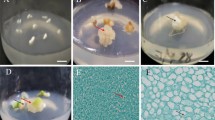Abstract
Peanuts (Arachis hypogaea L.) are widely cultivated as a rich source of protein and oil. Although protocols for the regeneration of peanut via somatic embryogenesis and organogenesis have been developed, most of them have resulted in low frequencies of plant recovery. In this report, we describe a protocol for plantlet formation at high frequency from somatic embryos. Morphologically abnormal somatic embryos germinated and produced roots only in medium devoid of growth regulators. Shoots emerged from the undeveloped plumule of these rooted embryos in medium containing both 6-benzyladenine (BA) and kinetin (KN), or in medium with thidiazuron (TDZ) alone. In Murashige and Skoog basal medium supplemented with 8.9 µm BA and 14 µm KN, 86% of the embryos developed shoots. Substitution of BA and KN with 22.7 µm TDZ increased plant recovery from 86% to 92%. Plants grown on TDZ had multiple shoots. Eighty-four percent of these plants survived in sandy soil and were grown to maturity.
Similar content being viewed by others
Author information
Authors and Affiliations
Additional information
Received: 12 February 1996 / Revision received: 11 July 1996 / Accepted 30 April 1997
Rights and permissions
About this article
Cite this article
Chengalrayan, K., Mhaske, V. & Hazra, S. High-frequency conversion of abnormal peanut somatic embryos. Plant Cell Reports 16, 783–786 (1997). https://doi.org/10.1007/s002990050320
Issue Date:
DOI: https://doi.org/10.1007/s002990050320




